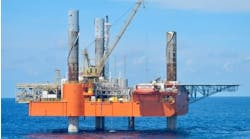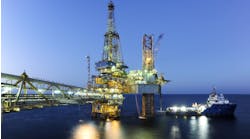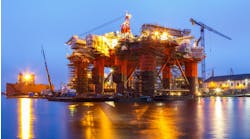FLOATING TECHNOLOGY: Deep-draft floating platform designed to weather global ice, seismic loading
As the eastern and northern Sakhalin regions prepare for an upsurge of field development, new platform concepts will be needed to counter wave, wind, ice, and seismic loads, which hamper production in this northern Pacific location.
One solution is a floating installation with a novel mooring arrangement, designed to improve the platform's vertical, horizontal, and angular stability. S. Karlinsky and V. Mrykin of Rubin, Russia's central marine engineering design bureau, outlined the possibilities at the Offshore Mediter ranean Conference in Ravenna.
The proposed design relates to an oil and gas drilling/production facility located offshore Sakhalin Island in water depths of 120-160 meters. This, the authors claimed, could be built by local Russian or Far Eastern shipyards. The concept is similar to a truss-configured Spar, with ballast in the truss section to aid the platform's stability. Typically, the Spar is moored with sloped lines in a star-shaped formation, with hawsers and piled anchors maintaining the platform's position above the wells.
This way, displacement of the hull caused by external disturbance would not exceed values permitted for the risers. In water depths of 200 meters and deeper, truss Spars can withstand wave and seismic agitations due to the difference between the wave period and the platform's oscillation period.
However, these types of facilities offer poor resistance to the global ice load, the authors point out. Pressure induced by drifting ice is liable to shift the floating hull in a horizontal direction toward a non-permissible offset. Heel and submergence effects are also likely due to the strong tension in the anchor legs (from the side where the ice load is applied) and the small waterplane area. To prevent excessive platform setdown, the designers must increase the waterline area, but this increases the ice load.
Adding substructure
The ice-resistant floating platform is moored by heavy chains.
As a solution to these problems, Rubin proposes adding a hull substructure to the floating platform, comprising - as with a Spar - vertically mated sections. These would include a watertight column and a vertically-oriented permeable part, at the end of which would be attached many heavy pendant mooring chains. The slacked chains would lie partially on the seabed, providing additional vertical stability, and horizontal and angular stability, the authors say.
It would also be sufficiently wave, wind, and current-resistant; however, it would not withstand typical Russian offshore global ice forces, due to excessive overturning moment arising from the low stationkeeping force. As a remedy, the authors propose a two-tier mooring arrangement:
- Upper mooring system, as applied to a Spar, with hawsers on the floating hull's upper portion and sloped (for ice-load resistance) tension legs secured by bottom anchors
- Lower system, comprising the heavy pendant chains, the latter fixed to the butt-end of the permeable part of the vertical column and secured via pile anchors.
Platform stability
Low sensitivity to seismic vibration is achieved through the free resting of the substructure's lower section. And resistance to wave loads is increased, due partly to the hull waterline's small area and also to the possibility of regulating the platform's oscillation period, through optimizing tension of the upper legs (in turn transmitting part of the load to the chains).
The platform's stability and its resistance toward external loads would be provided for as follows: During an earthquake, the ground shakes in the form of vertical and horizontal accelerations and shearing. Pile anchors would displace mainly in a horizontal direction, resulting only in a small, non-critical vibration of the hull. All vertical forces, induced both by the earthquake and waves or periodic variation of the sea level, would be absorbed through the vertical liability of the tendons and chains.
Even in a severe storm, the resultant wave forces and moments should not cause marked amplitude of the floating leg oscillations, provided that tension of the tendons and chains is optimized to handle oscillation periods well beyond the wave resonance periods.
Should the facility be threatened by drifting ice, the tendons and chains could be used to compensate both the force and overturning moment that the ice might induce, thereby preventing facility setdown or offset. Under the ice effect, around waterline level, the tendons would be acting to resist shearing and overturning, while the chains system would prevent the substructure overturning. This characteristic is not available with Spars, the authors point out. Main operational parameters for the Rubin platform concept include:
- Topside mass = 9,000 tons
- Deck dimensions = 60 meters by 60 meters by 5 meters
- 36 (3-meter by 3-meter) well slots
- Topside clearance = 20 meters
- Water depth = 140 meters.
Permissible displacements are:
- Translational motions are less than 4-5% of the distance to the seabed from a keel joint, in static mode, and 10-12% in dynamic mode
- Angular motions are less than 2-3 degrees in static and 6-8 degrees in dynamic mode
- Vertical motions range are within 6-8 meters (ice collar height).
The authors concluded that an ice-resistant Spar would have impermissible displacements under ice and wave influence and would be difficult to build and to mate. It is doubtful whether Russian yards could assemble such a structure. The ice-resistant floating platform with pendant chains would exhibit lesser motions and would not be as heavy, and could therefore be built by yards in the region.




